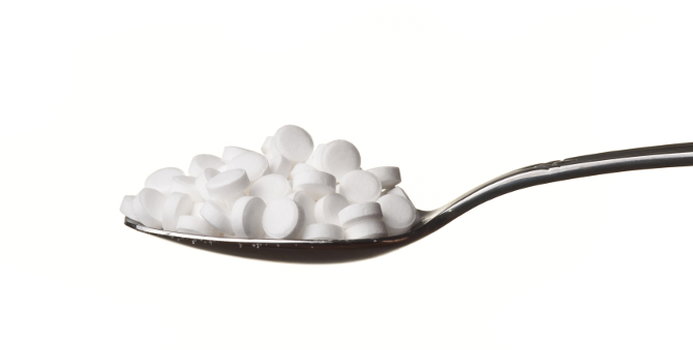Some of the safer choices for sugar substitutes are Sugar Alcohols, also known as Non-Carcinogenic Carbohydrate Sweeteners. These sugar replacers are often found naturally occurring in fruits and vegetables and are carbohydrates. Although sugar alcohols do provide some calories, it is typically a fraction of the calories provided by basic white sugar. They are absorbed into the body slowly or incompletely and require little to no insulin to metabolize. Some benefits of sugar alcohols are that they do not promote dental cavities because they are not converted into acids by the bacteria in your mouth that produce cavities. FDA has approved the label claim stating that sugar alcohols do not promote tooth decay. Typically they are added to foods to add bulk, improve texture, prevent browning and increase sweetness.
However, sugar alcohols are sometimes only half as sweet as sugar so some processed foods may combine them with other artificial sweeteners. Another potential negative for sugar alcohols is that they can cause some laxative effects or diarrhea if consumed in large amounts. FDA does require a laxative effect warning on products containing over 50 grams of sugar alcohols. The "safe intake" limits are the amounts that you will most likely not experience laxative effects.
1. Erythritol
Brand Names: ZSweet, Wholesome Sweeteners, Now Foods, NuNaturals, Organic Zero, Zerose
Sweet Level: ~70% as sweet as basic white sugar.
Erythritol occurs naturally in some fruits but as a sweetener it is typically made from fermenting glucose with yeasts. It can be derived from corn, so look for GMO-free choices on store shelves. Also be aware that this sweetener is often added to products that contain other artificial sweeteners like Aspartame, or Sucralose. This sugar substitute is considered relatively safe because it is absorbed into the bloodstream and excreted unchanged in urine. It also tends to have less laxative effects that other sugar alcohols. Some mild nausea has been reported with high use of this sweetener.
Safe intake: 50g per day
2. Maltitol
Brand Names: Lesys, Maltisweet, SweetPearl
Sweet Level: ~90% as sweet as basic white sugar
This sweetener is not completely calorie free; it has 2 calories per gram. This sweetener is also a sugar alcohol and is made from maltose which is found in starch. It is either made from corn or wheat. The Joint Food and Agriculture Organization/World Health Organization Expert Committee on Food Additives (JECFA) has given Maltitol its highest safety rating, and has not placed specific limits on its use.
Safe Intake: 100g per day
3. Sorbitol
Brand Names: Sorbitol, or is sold with other artificial sweeteners
Sweet Level: ~60% as sweet as basic white sugar
This sweetener is made from the glucose in cornstarch or corn, using enzymes are used to break up vegetable starch and convert it into Sorbitol. Most corn in the US is genetically modified, so look for GMO-free options when available. This sweetener provides 2.6 calories per gram. Sorbitol naturally occurs in fruit. Like other sugar alcohols, larger amounts may have a laxative effect or cause diarrhea.
Safe Intake: 50 grams per day
4. Xylitol
Brand Names: Listed on labels as Xylitol or as sugar alcohol.
Sweetness Level: Equal to basic white sugar
Xylitol provides 2 calories per gram and looks very similar to sugar but has a third as many calories. It is also considered one of the closest in taste to regular sugar. Xylitol is found in vegetables and fruits but typically it is made from corn. Some stores sell Xylitol made from the birch tree for those who are avoiding corn and corn products. More than the safe intake level can result in diarrhea.
Safe Intake: 25 grams per day

Emily DeLacey MS, RD is a Registered Dietitian and currently working in Jamaica as a HIV/ AIDS Prevention Specialist. She attended Central Washington University for her Bachelor's Degree in Science and Dietetics and continued on after her internship to Kent State University for her Master's Degree in Science and Nutrition, with a focus on public health and advocacy. She served as a U.S. Peace Corps Volunteer in Malawi 2012-2014 working as a Community Health Advisor in a rural village, immersing in the joys of life without electricity or running water. She has been to 20+ countries and 47 of the 50 states in the US. Traveling, adventuring and experiencing new cultures has made her a passionate advocate for the equality of nutrition and wellness for all people.



